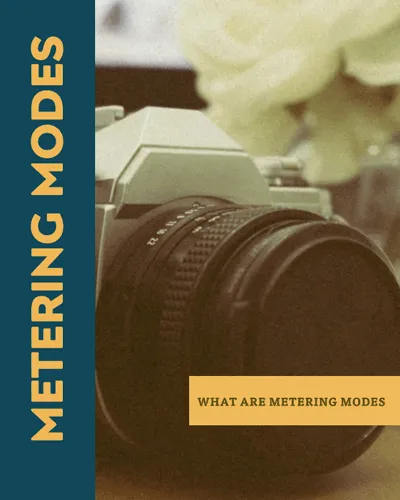
Photography as a Hobby for Beginners: Unlock Your Artistic Vision
Photography can be a fulfilling and enjoyable hobby that brings a creative outlet to your


As someone who loves taking pictures, are you disappointed with the outcome of the photos? It’s possible that you might not have a thorough understanding of what are metering modes on your camera. When I first started in photography, I sometimes end up with photos that were under or overexposed. After learning about metering modes, I realized that the key to capturing well-exposed images lies in choosing the right metering mode for the scene.
Metering is a crucial step in photography as it allows a camera to determine the correct exposure to a scene.
The camera measures the light that enters its sensor and adjusts the shutter speed and aperture to achieve the perfect exposure. Essentially, metering helps to ensure that photos are neither too bright nor too dark. DSLRs and mirrorless cameras have different metering modes like Matrix, Center-Weighted, and Spot Metering.
These modes calculate the average light of different areas in the frame. While the camera’s light meter is generally reliable in determining the proper exposure, it may be deceived by the presence of multiple light sources, such as during a sunset where the horizon is brighter than the sky.
Understand that each camera manufacturer sometimes uses different names for their metering modes. Canon Nikon, and Sony
Most digital cameras have a metering mode called Matrix or Evaluative Metering. This mode divides the frame into zones and analyzes them individually to determine light and dark tones. The camera then uses a proprietary formula to gauge exposure, giving priority to the area where the autofocus is set.
This mode is suitable for most photography needs, including landscape and portrait photography. Matrix metering is a modern and sophisticated way of measuring light in a scene, gathering information from the entire frame. Different manufacturers call this mode by different names, such as Evaluative, Matrix, or Multi-pattern Metering. It is best used when the entire scene’s exposure is important, such as in landscapes, but may not be appropriate in scenes with unusual lighting.
Center-weighted metering is a mode that prioritizes the Center of the image when deciding the proper exposure. It measures the entire scene but places extra emphasis on the light values in the middle. Center-weighted is useful when placing the subject in the Center of the frame. Used for portraits where the person fills the frame.
The advantage of center-weighted metering is that it gives greater importance to the middle of the photo. If you take a photo of a child in front of a black background, using center-weighted metering can help you get a well-exposed picture. However, the drawback of center-weighted metering is that it’s not very precise. It weights the center of the image more heavily, but it still incorporates measurements from the entire scene.
This metering mode should be used if your framing is focused in the center alone. Center-weighted metering is ideal for concert photography. Where the subject is surrounded by darkness.
Spot metering is a specific camera metering mode that calculates the precise exposure of a small area instead of the overall image. Unlike center-weighted or matrix metering, spot metering only uses a tiny area of the scene, usually ranging between 1-5% of the entire frame. This makes it the most precise metering mode available.
Spot metering is used when the subject occupies a small portion of the frame and there’s a significant difference in brightness between the subject and background. For example, taking a picture of the moon or a small object in a crowded place.
Using spot metering along with the auto-exposure lock can be beneficial. Allowing you to set the exposure for a particular spot and then adjust the composition without changing the exposure. However, spot metering can be challenging for novices, as choosing the wrong metering point can result in an under-exposed or over-exposed image.
Highlight Priority metering mode aggressively protects the highlights in your shots. Useful when shooting scenes with bright areas near your subject. This mode can be too aggressive in certain scenes, such as when there are bright but unimportant areas of your shot. In such cases, highlight-weighted metering works well.
Nikon’s cameras have a new metering mode called “highlight-weighted” that puts the most emphasis on avoiding overexposure of the brightest parts of the image. Useful for high-contrast images or when you want to preserve as much detail as possible in highlights. Highlight Priority mode is beneficial for backlit photos, snowy landscapes, concerts, mixed lighting, stage performances, and other high-contrast situations.
Average metering, sometimes called center-weighted metering, is a setting that measures the light around the Center of the image, usually covering about 7% of the image. This mode averages the light readings in the central and calculates the best exposure for the scene. Average metering is best used for static subjects and scenes with even lighting. However, it may not be suitable for scenes with high-contrast or drastic shadows and highlights, as it results in overexposed or underexposed photos.
Overall, average metering is a good starting point for beginners as it provides a balanced exposure to most situations.
Partial metering covers a small area of the frame, but slightly larger than spot metering.
Partial metering works well for subjects that are darker than their background, such as in back-lit shots or when shooting tiny subjects. It collects data from a small circular area in the metering center of the camera, covering about 10-15% of the entire scene.
The choice between spot and partial metering comes down to the size of the subject in the entire frame. Partial metering is ideal for nature, wildlife, and portraits with a clear subject.

How to override metering modes on your camera. This process varies by camera. It typically involves pressing a button or going into the menu. Once you’ve accessed the metering mode settings, you can choose from center-weighted, spot, or evaluative metering. Each mode calculates the exposure differently, so it’s important to choose the best mode for the scene.
By overriding the camera’s default metering, you can achieve more accurate exposures and have greater control over the photo.
It’s important that you understand the lighting conditions you are shooting in. In bright, high-contrast scenes, spot metering is a good option. It can provide accurate readings for a small area. In low-light, center-weighted metering or evaluative metering modes might be best. As it considers the entire frame. Understanding the lighting conditions is important in determining the appropriate metering mode, it helps you avoid over or underexposed images. For instance, in a sunset shot, evaluative metering helps capture the dynamic range of the scene and produces a well-exposed image. Therefore, it’s important to understand the lighting conditions to select the best metering mode.
Subject placement plays a crucial role in selecting your camera metering mode. If your subject is placed in the center of the frame, center-weighted metering would be the ideal choice. If your subject is off center, spot metering would be more suitable as it measures the light in a smaller area. Matrix metering is great for scenes with multiple subjects, such as a group of people, as it meters the entire frame. Ultimately, it’s important to consider your subject’s placement when choosing your metering mode to ensure that you get a well-exposed and balanced image.
Another important feature to consider is the contrast range. Contrast range refers to the difference between the darkest shadows and the brightest highlights. A high contrast range can make it difficult for your camera’s light meter to accurately measure the scene, leading to over or underexposed photos.
Using spot metering allows you to measure the light in a specific area, ensuring your subject is properly exposed. Alternatively, if your scene has a lower contrast range, such as a landscape with even lighting, you can use matrix metering. Taking into account the contrast range, you can choose the appropriate metering mode and capture photos with the correct exposure.
Depth of field can be a crucial factor when choosing a camera metering mode. When shooting a portrait with a blurred background, use a metering mode that focuses on the subject. Spot metering, for example, measures the light in a small area. If you’re shooting a landscape with a large deep depth of field, matrix metering takes readings from the entire frame. This mode is great for capturing the full range of tones, ensuring the highlights and shadows are properly exposed.
By considering the depth of field of your scene, you can choose the right metering mode to achieve the desired effect.
When choosing a camera metering mode, consider your environment. If you are in a busy environment, like a crowded street or a busy park, it’s essential to use a metering mode that considers the entire frame, like matrix or evaluative metering.
Conversely, if you are in a controlled environment, a studio. Use spot metering to get precise exposure readings for the face or the eyes. For low light scenes like indoor or night photography, spot metering can help properly expose the scene.
Overall, the shooting environment plays a crucial role in choosing the right metering mode to capture well-exposed and visually appealing photos.
Exposure compensation adjusts the camera’s initial calculated exposure. It is used when the camera’s metering mode is inaccurate or the histogram shows over or under exposure. This feature can increase or decrease the final exposure of white or black scenes by adjusting the camera’s flawed measurement based on 18% grey. Adjusting exposure compensation is easy: just press a button or turn a dial, usually found in aperture or shutter priority mode.
In summary, exposure compensation values allow you to fine-tune the exposure of an image beyond what the camera’s metering system determines. It is useful in high-contrast situations or with backlit subjects. Metering modes affect exposure compensation. Adjust it by pressing the ± button or turning a dial on the camera.
Exposure lock allows you to lock the exposure for a particular subject or scene. Useful for when you want to recompose the shot without losing the exposure settings. When combined with metering modes, exposure lock can help you get an accurate exposure for the subject regardless of its position in the frame. You can measure the light in the center of the frame by using the center-weighted metering mode. After that, you lock the exposure and focus on the subject before taking the shot. This allows you to capture the subject with the correct exposure.
One common mistake when selecting your metering modes is relying solely on the camera’s automatic settings. It’s important to understand the different modes and choose the most appropriate one based on the shooting conditions. Another mistake is not checking the exposure settings and the histogram after taking a photo. To correct the exposure, you should review the histogram to confirm that adjustments are required. Experiment with different metering modes to see which one works best for the specific shooting situation. With practice, you can avoid these common mistakes and achieve accurate and consistent exposures.

In conclusion, understanding camera metering modes is crucial for any photographer who wants to capture well-exposed photos. By selecting the appropriate metering mode for each shooting scenario, you can ensure that your images are correctly exposed, even in tricky lighting conditions.
Remember, there is no one-size-fits-all solution. With practice, you can develop a better understanding of how each metering modes works, and learn how to troubleshoot exposure issues. Ultimately, mastering your camera metering modes can take your photography to the next level and help you achieve the desired results in your photos.
Matrix metering mode is a camera setting that measures the light in a scene by gathering data from the entire frame. It is a sophisticated and modern way of determining proper exposure, and is great for capturing complex scenes with varied lighting. This mode is particularly useful when you want your camera to balance the exposure for multiple subjects in the frame.
Matrix metering and evaluative metering are two different methods for measuring light when taking photos. Matrix metering considers the whole image to find the right exposure, while evaluative metering breaks the image into sections and analyzes them separately. Evaluated metering is more accurate in certain situations, it considers factors such as the subject’s position and the brightness of the background.
The best metering mode for landscape photography depends on the scene and lighting conditions. Use evaluative metering when there are both bright and dark areas in the scene, and use spot metering to focus on specific details. Some photographers also prefer using center-weighted metering for landscapes since it emphasizes the Center of the frame. Ultimately, the best metering mode will vary depending on the photographer’s preferences and the specific landscape they are capturing.
For portrait photography, the center-weighted metering mode is often the best. This mode prioritizes the middle of the image, making it great for scenes where your subject is centred. By using center-weighted metering, you can ensure that your portrait is properly exposed, and your subject stands out from the background.
Center-weighted average metering is a camera metering mode that prioritizes the Center of the image when deciding the proper exposure. It measures the whole scene but places extra emphasis on the light values in the middle. This metering algorithm is particularly useful for scenes with a subject located in the center of the frame, such as portraits or concert photography.
Multi-pattern metering is a camera metering mode that uses multiple zones to determine the correct exposure for a scene. It takes into account the brightness and contrast of different areas in the frame to create a well-exposed image. This metering mode is useful for complex scenes with various light sources and tones, and it can help you capture accurate and balanced photos.

Photography can be a fulfilling and enjoyable hobby that brings a creative outlet to your

Welcome to our guide to Photoshop tutorials for beginners: A Complete Beginner’s Tutorial for Learning

Creating stunning images is all about nailing the perfect colour grade. It’s what makes your